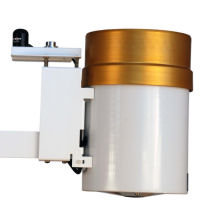
Overview
The TE525-ET, manufactured by Texas Electronics, has a 6 in. orifice and measures rainfall in 0.01 in. increments. The TE525-ET funnels precipitation into a bucket mechanism that tips when filled to a calibrated level.
Read MoreBenefits and Features
- Accuracy is ±1 percent at rates up to 1 in./hr
- Compatible with all Campbell Scientific data loggers (including the CR200(X) series)
- High precision—tips at 0.01-in. increments
- Compatible with the CWS900-series interfaces, allowing it to be used in a wireless sensor network
Images

Related Products
Technical Description
For this version of the TE525 tipping bucket rain gauge, the cable terminates in a connector and is the ideal length for attachment to the ET107 or ET106 ETo Weather Station. The TE525-ET has a 6" orifice and measures rainfall in 0.01 inch increments. The TE525-ET funnels precipitation into a bucket mechanism that tips when filled to when filled to a calibrated level.
Videos & Tutorials
Compatibility
For this version of the TE525 tipping bucket rain gauge, the cable terminates in a connector and is the ideal length for attachment to the ET107 or ET106 ETo Weather Station.
Specifications
| Sensor Type | Tipping bucket/magnetic reed switch |
| Material | Anodized aluminum |
| Temperature | 0° to 50°C |
| Resolution | 1 tip |
| Volume per Tip | 4.73 ml/tip (0.16 fl. oz/tip) |
| Rainfall per Tip | 0.254 mm (0.01 in.) |
| Accuracy | 1.0% up to 2 in./h (50 mm/h) |
| Cable | 2-conductor shielded |
| Funnel Collector Diameter | 15.4 cm (6.06 in.) |
| Height | 24.1 cm (9.5 in.) |
| Cable Length | 139.7 cm (55 in.) |
| Tipping Bucket Weight | 0.9 kg (2.0 lb) |
| Cable Weight | 0.1 kg (0.2 lb) per 3.05 m (10 ft) length |
Related Documents
Related FAQs
Number of FAQs related to TE525-ET: 14
Expand AllCollapse All
-
Not enough tips or too many tips.
-
The accuracy of the TE525-L diminishes as rainfall intensity increases (see the Accuracy specification) because at higher intensities, rain will keep pouring into the tipping mechanism as it is tipping, causing missed tips. The maximum listed intensity in the specifications is 2 to 3 in./hr, which would give an accuracy of +0%, -5%.
-
Replacement funnels can be ordered by calling an application engineer at Campbell Scientific.
-
A TE525-L can be converted to a TE525MM-L and vice versa because the inner tipping mechanisms are the same. To convert a TE525-L or TE525MM-L to a TE525WS-L, the rain gage must be sent in to Campbell Scientific to change the tipping mechanism. If an 8 inch funnel is used on a TE525-L or TE525MM-L without changing the tipping mechanism, the multipliers for the rain measurement will change. For information about these multipliers, see the TE525 Instruction Manual.
-
When a rain gage is out of calibration, it is usually because of the buildup of dirt and grime on the internal surfaces of the tipping bucket mechanism. Cleaning the internal surfaces usually brings the rain gage back into calibration. It is also possible that a rain gage is out of calibration because it is no longer level.
To minimize the possible occurrence of calibration errors, perform routine cleaning and maintenance of the rain gage at least once every three months. The environmental conditions at a particular site may require a facility to perform cleaning, leveling, and maintenance on a much more frequent schedule.
-
The most common errors are either that the rain gage appears to have drifted out of calibration or that the tips are not being correctly recorded by the datalogger.
-
To incorporate a sensor that is compatible with wireless sensor interfaces into a wireless network, a CWS900-series wireless sensor interface is needed, as well as an A205 CWS-to-PC interface to configure it.
-
The information included on a calibration sheet differs with each sensor. For some sensors, the sheet contains coefficients necessary to program a datalogger. For other sensors, the calibration sheet is a pass/fail report.
-
The CS705 Tipping Bucket Snowfall Adapter cannot be used directly with the TE525-L or TE525MM-L because of the funnel size. To make the rain gages compatible, they can either be sent to Campbell Scientific to be converted to a TE525WS-L, or an 8 inch funnel can be installed. If the funnel is used, see the instruction manual for the appropriate multipliers, as they will change.
-
This depends on the information contained in the calibration sheet:
- If the calibration sheet contains coefficient information, Campbell Scientific keeps a copy, and a replacement copy can be requested.
- If the calibration sheet does not contain coefficients, Campbell Scientific does not keep a copy. It may be possible to contact the original manufacturer for a replacement copy.

